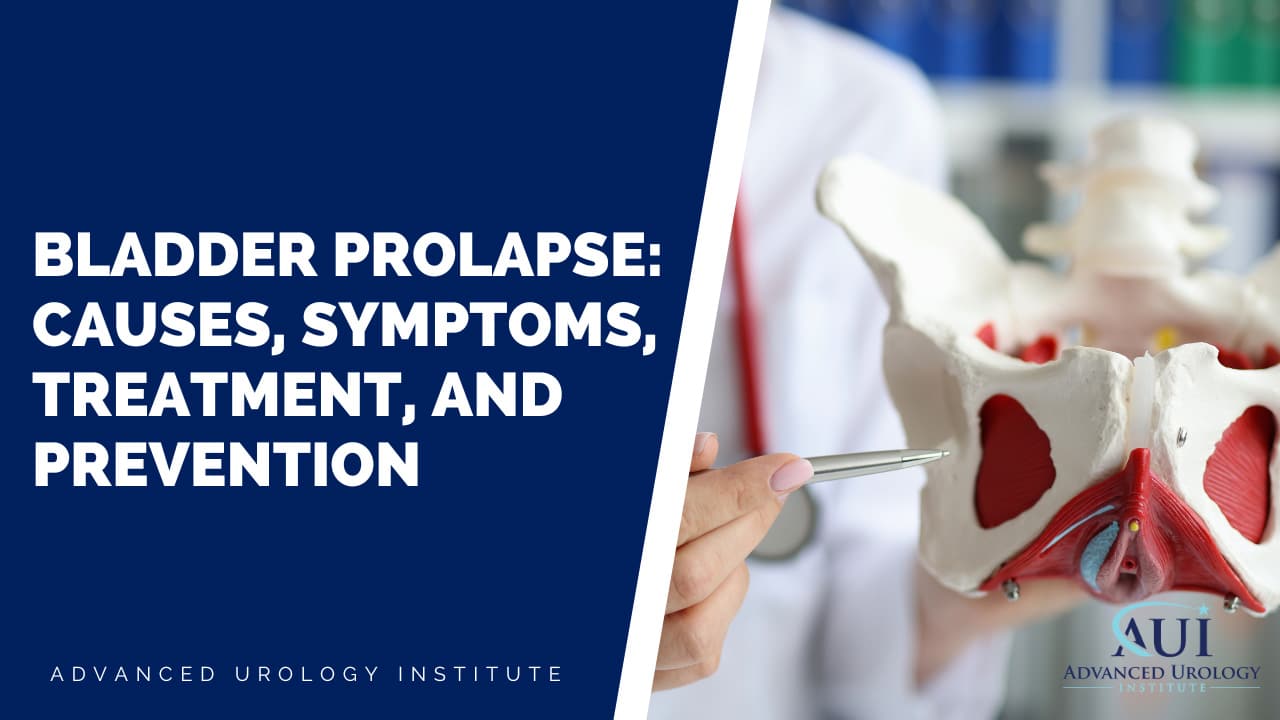Bladder Prolapse: Causes, Symptoms, Treatment, and Prevention
3 Key Takeaways:
- Bladder prolapse is caused by weak pelvic floor muscles, which can be caused by childbirth, pregnancy, aging, chronic coughing, obesity, hysterectomy, and heavy lifting.
- Symptoms of bladder prolapse include feeling pressure or fullness in the pelvic region, urinary incontinence, pain during sexual intercourse, and a bulge or protrusion in the vaginal area.
- Treatment options for bladder prolapse include non-surgical treatments (e.g. pelvic floor exercises, pessary, lifestyle modifications) and surgical treatments (e.g. anterior vaginal repair, vaginal mesh, sling placement, hysterectomy). Prevention includes regular exercise, maintaining a healthy weight, addressing persistent coughing, and pelvic floor physical therapy.
 You wake up one day to an unpleasant sense of fullness and pressure in your pelvic region — an anomaly you cannot shake off. A trip to your doctor reveals a dreaded condition: bladder prolapse, a condition where the bladder slips downwards into your vagina due to weak pelvic floor muscles.
You wake up one day to an unpleasant sense of fullness and pressure in your pelvic region — an anomaly you cannot shake off. A trip to your doctor reveals a dreaded condition: bladder prolapse, a condition where the bladder slips downwards into your vagina due to weak pelvic floor muscles.
This issue is not to be ignored. Recognizing bladder prolapse and addressing it is crucial for maintaining your quality of life.
Causes of Bladder Prolapse
The primary culprit behind the condition is a weak pelvic floor. This can be caused by an array of factors. Childbirth and pregnancy can strain and weaken these muscles, increasing the risk of prolapse. Aging, with its inevitable wear and tear, can also be a pivotal factor.
Chronic coughing or straining, often due to lung conditions or constipation, places continuous pressure on your pelvic floor, leading to bladder prolapse. Other factors contributing to pelvic organ prolapse include obesity, hysterectomy, and repeated heavy lifting.
Signs and Symptoms of Bladder Prolapse
Bladder prolapse announces itself subtly. You might first notice a feeling of pressure or fullness in your pelvic region. As your bladder struggles to empty completely, urinary incontinence, or leakage, might become a recurring embarrassment.
Discomfort or even pain during sexual intercourse can also signify bladder prolapse. The most tangible symptom, however, is noticing a bulge or protrusion in your vaginal area. If you experience any of these symptoms, do not hesitate to consult urologists in FL.
Diagnosis
Bladder prolapse diagnosis starts with your medical history and a physical examination. Your doctor will typically perform a pelvic examination, examining your vagina while you are in various positions and during strain.
Imaging tests such as ultrasound or MRI can provide a detailed visualization of your bladder’s position. Urodynamic testing evaluates your bladder’s functionality, determining whether your symptoms align with the condition.
Treatment Options for Bladder Prolapse
Luckily, bladder prolapse has a wide range of treatment options. Non-surgical routes include performing pelvic floor exercises, using a pessary (a device inserted into the vagina to support the bladder), and making lifestyle modifications such as losing weight and avoiding heavy lifting.
Surgical options include anterior vaginal repair, vaginal mesh, or sling placement. In severe cases, a hysterectomy might be considered. Experts are increasingly exploring less invasive techniques such as laparoscopic or robotic-assisted surgery.
Prevention
Combating bladder prolapse also involves implementing preventative measures. Regular exercise specifically aimed at strengthening the pelvic floor muscles can be beneficial. Maintaining a healthy weight reduces overall pressure on your pelvic floor.
If you have a persistent cough, addressing it is crucial. Learn proper lifting techniques to avoid unnecessary strain. You might also consider pelvic floor physical therapy, an underutilized but effective approach to prevention.
Complications
Bladder prolapse might seem inconvenient, but leaving it untreated can result in complications like urinary tract infections and recurrent prolapses. Sexual dysfunction is a feared consequence, while the sheer discomfort can significantly impact your quality of life.
Conclusion
Bladder prolapse, while daunting, can be managed with the right help. Being proactive about your pelvic health is a vital part of your overall well-being.
If you find yourself in Florida, struggling with symptoms of bladder prolapse, the Advanced Urology Institute stands ready to help. As the largest urology practice in Florida, our experienced team is committed to providing comprehensive care and guiding you from diagnosis to recovery. Restoration of your pelvic health is our utmost priority.
References:
- “Hysterectomy: Purpose, Procedure, Benefits, Risks & Recovery.” 16 Oct. 2021, https://my.clevelandclinic.org/health/treatments/4852-hysterectomy.
- “Urodynamic Testing | Urogynecology & Reconstructive Pelvic Surgery.” https://bladder-pelvic-health.wustl.edu/diagnostics-testing/urodynamic-testing/.
- “Urinary Incontinence – Symptoms – Urology Care Foundation.” https://www.urologyhealth.org/urology-a-z/u/urinary-incontinence.

